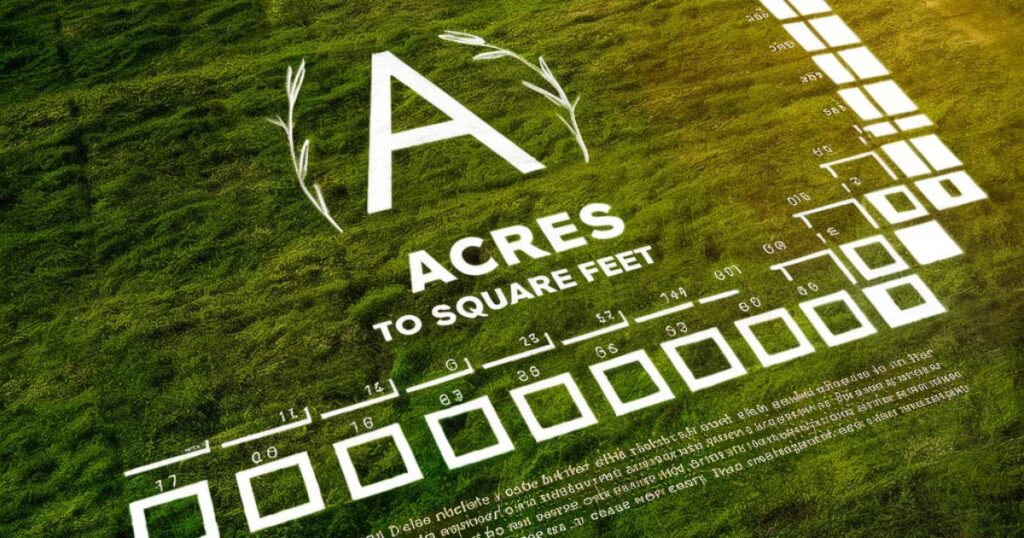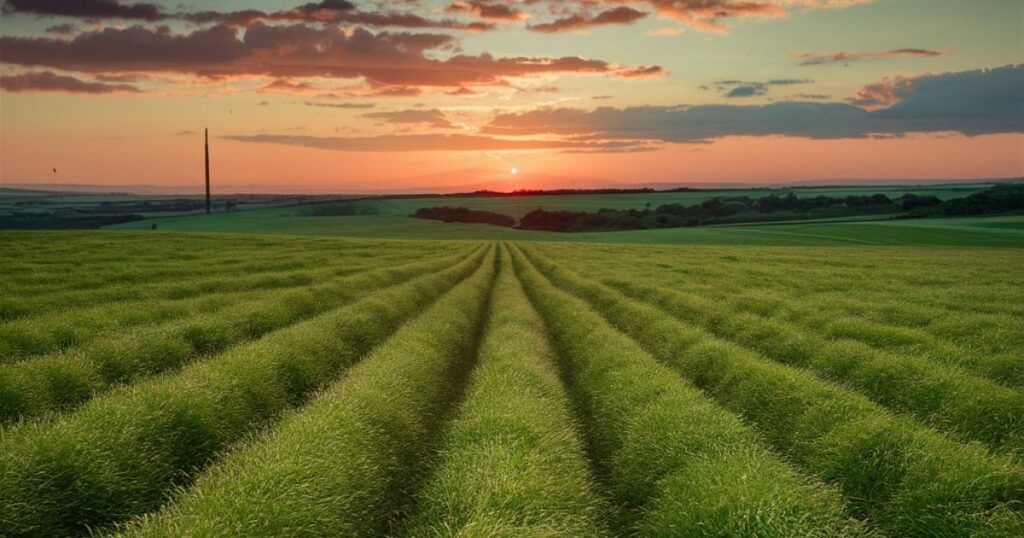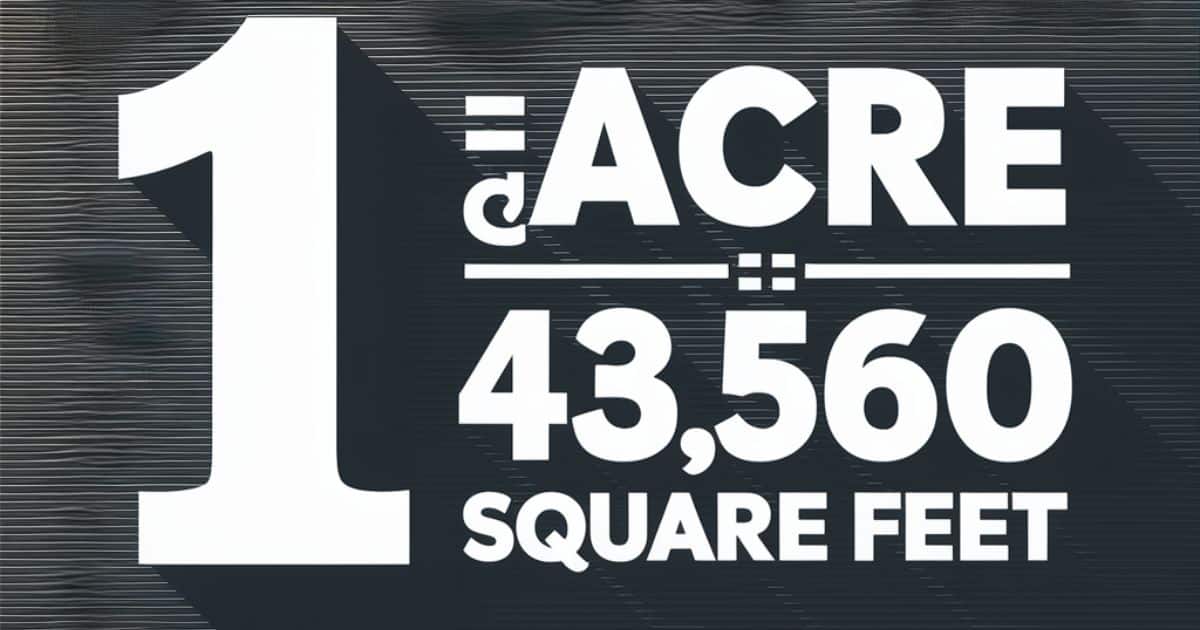Ever wondered just how big an acre really is? You’re not alone. Whether you’re eyeing a new property, planning a farming venture, or just curious about land measurements, understanding the size of an acre is crucial.
In this comprehensive guide, we’ll dive deep into the world of acres, exploring everything from their basic definition to practical applications. So, let’s unravel the mystery of how many square feet are in one acre and why it matters.
The Basics: What Exactly Is an Acre?
Before we jump into the nitty-gritty of square footage, let’s get to know the acre a bit better.
The acre has a rich history dating back to medieval times. Originally, it was defined as the amount of land a yoke of oxen could plow in one day.
Talk about a workday! This definition varied widely depending on the land’s condition, the crop being sown, and even the strength of the oxen. Over time, this rather imprecise measure evolved into the standardized unit we use today.
In modern USA land measurements, an acre is a go-to unit for describing larger plots of land. It’s commonly used in real estate, agriculture, and land development. But how does it stack up against other units? Here’s a quick comparison:
- 1 acre = 0.4047 hectares
- 1 acre = 0.0015625 square miles
- 1 acre = 4,840 square yards
Interestingly, while the acre is a standard unit in the US, it’s considered an imperial unit and isn’t part of the metric system. Many other countries primarily use hectares for land measurement, which can lead to some confusion in international land dealings.
Breaking It Down: Square Feet in an Acre

Now, let’s get to the heart of the matter. How many square feet are in one acre?
The magic number is 43,560 square feet.
That’s right, one acre equals 43,560 square feet. It’s a number worth remembering if you’re in the land business. But what does 43,560 square feet actually look like?
Imagine a square plot of land measuring about 208.71 feet on each side. That’s roughly the size of a football field without the end zones. Or, if you’re more of a tennis enthusiast, picture 16 tennis courts laid out side by side.
To put it in more relatable terms:
- It’s about 90% of a full American football field, including the end zones
- It’s equivalent to 16 tennis courts
- It’s roughly the size of 156 parking spaces in a typical parking lot
- If you’re a gardener, think of it as 180 10×10 foot garden plots
Common Misconceptions
Many folks assume an acre is always a square shape. Not so! An acre can be any shape as long as its total area equals 43,560 square feet. It could be a long rectangle, an odd polygon, or even a circle. The shape doesn’t matter – it’s all about that total square footage.
Another common misconception is that an acre is 100 yards long. While this might be close (an acre is about 208.71 feet or 69.57 yards on each side if square), it’s not quite accurate. This misconception likely stems from the acre’s historical definition related to plowing.
Why Knowing Square Feet per Acre Matters
Understanding how many square feet are in an acre isn’t just trivia. It has real-world applications that can impact your wallet and your plans. Let’s explore a few:
Real Estate Transactions:
When buying or selling land, knowing the square footage helps you accurately assess value. A difference of even a few square feet can mean thousands of dollars in property transactions.
For example, if land is selling for $10 per square foot, a miscalculation of just 100 square feet could result in a $1,000 difference in price.
Agricultural Planning:
Farmers use acre measurements to plan crop yields, irrigation systems, and fertilizer needs. Knowing the exact square footage helps in precise planning and resource allocation.
For instance, if a farmer knows that their wheat crop yields about 50 bushels per acre, they can accurately estimate their total yield based on their acreage.
Construction and Development:
Builders and developers rely on accurate land measurements to plan projects, estimate costs, and comply with zoning regulations.
Knowing how many square feet are in an acre helps them determine how many homes can be built on a plot of land or how much material they’ll need for a project.
Property Tax Assessments:
Many areas base property taxes on land area. Understanding your acreage in square feet ensures you’re being taxed accurately.
If your property is incorrectly assessed as being larger than it actually is, you could end up paying more in taxes than you should.
Landscaping and Lawn Care:
Landscapers and homeowners use acre measurements to determine how much seed, fertilizer, or other materials they need.
For example, if a bag of grass seed covers 1,000 square feet, you’d need about 44 bags to cover an acre.
Variations on the Acre: Not All Acres Are Created Equal
Just when you thought you had it figured out, along come some curveballs. Let’s look at a few variations on the standard acre:
The “Builder’s Acre”
Ever heard of a “builder’s acre”? It’s a term that’s caused more than a few headaches in the real estate world. A builder’s acre is typically smaller than a standard acre, usually around 40,000 square feet instead of 43,560.
Why the difference? Some say it’s for easier calculations, others claim it’s a marketing ploy. Whatever the reason, it’s crucial to clarify which type of acre you’re dealing with in any land transaction. Many lawsuits have erupted over this discrepancy, so buyer beware!
Here’s a quick comparison:
- Standard Acre: 43,560 square feet
- Builder’s Acre: Typically 40,000 square feet
- Difference: 3,560 square feet (about the size of a small house!)
Commercial Acres
In commercial real estate, you might hear about “commercial acres.” This isn’t a standard unit of measurement but rather a colloquial term. It usually refers to the usable land in a commercial property, excluding areas like parking lots or undevelopable portions.
The size of a commercial acre can vary widely, typically ranging from 30,000 to 40,000 square feet. Always get clarification when dealing with commercial acreage to ensure you’re on the same page.
For example, a “commercial acre” in a dense urban area might only include the building footprint and immediate surroundings, while in a suburban area it might include parking and landscaped areas.
Converting Acres to Square Feet and Vice Versa
Need to switch between acres and square feet? Here’s a handy guide:
- To convert acres to square feet: Multiply the number of acres by 43,560
- To convert square feet to acres: Divide the number of square feet by 43,560
- 2 acres = 2 x 43,560 = 87,120 square feet
- 100,000 square feet = 100,000 ÷ 43,560 = 2.29 acres
There are plenty of online calculators and smartphone apps that can do these conversions for you in a snap. But it’s always good to know how to do it manually, just in case!
Here’s a quick reference table for common conversions:
| Acres | Square Feet |
| 0.25 | 10,890 |
| 0.5 | 21,780 |
| 1 | 43,560 |
| 2 | 87,120 |
| 5 | 217,800 |
| 10 | 435,600 |
Beyond Square Feet: Other Acre Measurements

While we’re focused on square feet, it’s worth noting that acres can be expressed in other units too. Here’s a quick reference table:
| Unit | Equivalent to 1 Acre |
| Square Feet | 43,560 |
| Square Yards | 4,840 |
| Square Meters | 4,047 |
| Hectares | 0.4047 |
| Square Chains | 10 |
| Square Rods | 160 |
Some of these units, like chains and rods, are less commonly used today but still appear in some legal descriptions of land, especially in older documents.
Practical Examples: Putting Acre Knowledge to Use
Let’s look at some real-world scenarios where understanding “how many square feet are in an acre” comes in handy:
Case Study 1: Land Valuation
Imagine you’re looking at two properties:
- Property A: 1 acre listed at $50,000
- Property B: 50,000 square feet listed at $55,000
At first glance, Property B might seem like a better deal – more land for just a bit more money, right? But let’s do the math:
Property A: 1 acre = 43,560 sq ft Property B: 50,000 sq ft = 1.15 acres
Now we can calculate the price per acre:
- Property A: $50,000 per acre
- Property B: $47,826 per acre
Turns out, Property B is actually cheaper per acre!
Case Study 2: Fencing an Acre
Let’s say you want to fence your one-acre property. Assuming it’s a perfect square (which, remember, it doesn’t have to be), each side would be about 208.71 feet.
Total fencing needed: 208.71 x 4 = 834.84 feet
If fencing costs $10 per linear foot, your total cost would be about $8,348.40.
Case Study 3: Agricultural Yield
A farmer knows that their corn crop typically yields about 180 bushels per acre. They have a field that’s 1,305,000 square feet. How much corn can they expect to harvest?
First, let’s convert square feet to acres: 1,305,000 ÷ 43,560 = 29.96 acres
Now, calculate the yield: 29.96 acres x 180 bushels/acre = 5,392.8 bushels of corn
This kind of calculation is crucial for farmers in planning their harvests and estimating their income for the year.
Read this Post: Plan a Day Trip from Florence to Cinque Terre
The Future of Land Measurement
While the acre has been around for centuries, the way we measure and understand land is constantly evolving.
GPS and satellite technology have made land surveying more accurate than ever. Some experts even speculate that we might see a shift towards metric units in the future, with hectares potentially replacing acres.
Despite these advancements, the acre – and its equivalent in square feet – remains a cornerstone of land measurement in the USA. Understanding the relationship between acres and square feet will likely remain valuable for years to come.
Technological Advancements
Modern technology is revolutionizing how we measure and understand land:
- GPS Technology: High-precision GPS devices can measure land with centimeter-level accuracy.
- Drone Surveying: Drones equipped with cameras and sensors can quickly survey large areas of land.
- LiDAR: Light Detection and Ranging technology creates detailed 3D maps of terrain.
- Satellite Imagery: High-resolution satellite images allow for precise measurements of land from space.
These technologies are making it easier than ever to accurately measure and map land, but they still rely on our understanding of basic units like acres and square feet.
Wrapping Up: Why 43,560 Matters
So, there you have it – the ins and outs of how many square feet are in an acre. From its historical roots to modern-day applications, the acre plays a crucial role in how we measure, value, and use land in the United States.
Whether you’re a prospective land owner, a real estate professional, or just someone with a curiosity for measurements, understanding that magic number – 43,560 square feet in an acre – can be incredibly useful.
It’s more than just a number; it’s a key to unlocking accurate land valuation, effective property planning, and informed decision-making.
Remember, knowledge is power, especially when it comes to land. So the next time someone asks, “How many square feet are in an acre?” you’ll be ready with the answer and a whole lot more!
FAQ’s
How many houses can typically fit on one acre?
This varies widely depending on local zoning laws, house sizes, and lot configurations. In suburban areas, you might see 2-4 single-family homes per acre. In more densely populated areas, this number could be much higher with multi-family units.
Is an acre always a square shape?
No, an acre can be any shape as long as the total area equals 43,560 square feet.
How does an acre compare to a football field?
A standard American football field, including end zones, is about 1.32 acres. Without end zones, it’s closer to 1.1 acres.
Can the size of an acre vary by state?
No, the size of an acre is standardized across the United States at 43,560 square feet.
How do I measure an acre on my own property?
While professional surveying is the most accurate method, you can get a rough estimate using a long measuring tape or a GPS-enabled smartphone app designed for land measurement. Remember, an acre is any area totaling 43,560 square feet, regardless of its shape.
Why is an acre 43,560 square feet specifically?
This number comes from historical measurements. An acre was defined as an area one chain (66 feet) wide by one furlong (660 feet) long. 66 x 660 = 43,560 square feet.
How many acres are in a square mile?
There are 640 acres in one square mile.
Is an acre the same size everywhere in the world?
While the international acre is standardized at 43,560 square feet, some countries have slightly different definitions. For example, the Irish acre is about 1.6 times larger than the international acre.











